Background: Temporal augmentation can be done for either a reconstructive or an aesthetic purpose. Most reconstructive temporal augmentations are either due to a craniotomy defect or loss of normal muscle fill of the concave bony temporal fossa from surgery or trauma. Such augmentations take a more craniofacial approach and use various forms of bone cements and usually involve a large access through an extended scalp incision to place them deep into the temporal fossa below the muscle.
Conversely aesthetic temporal augmentations are most commonly done by injection either using synthetic fillers or fat placing them either into the muscle or above the fascia into the subcutaneous temporal tissues. Less commonly done, although permanent and often more effective, is a surgical approach using temporal implants. These are unique facial implants in that they are designed to augment muscle and not bone. As a result they are placed on top of the muscle under the deep fascial layer covering the muscle. To do so requires very small incisions in the temporal hair bearing areas.
While temporal implants could potentially be placed down at the bone level to push out the muscle, the use of bone cement on top of the muscle does not seem equally versatile due to its very firm material feel.
Case Study: This male, who was undergoing right vertical orbital dystopia (VOD) surgery, had a prior temporal augmentation using bone cement, in which the right side had numerous issues. Besides an irregular contour and inadequate projection to the other side, he had intermittent clicking of the implant. When the implant was pushed on it could be seen that the entire right temporal area/implant moved.


Case Highlights:
1) Temporal augmentation can be done by either a craniofacial or aesthetic approach which is done at different tissue levels.
2) Bone cements for temporal augmentation is typically done down at the bone level beneath the muscle.
3) Temporal implants are ultra soft silicone implants designed to be placed on top of the muscle beneath the fascia.
Dr. Barry Eppley
Indianapolis, Indiana





